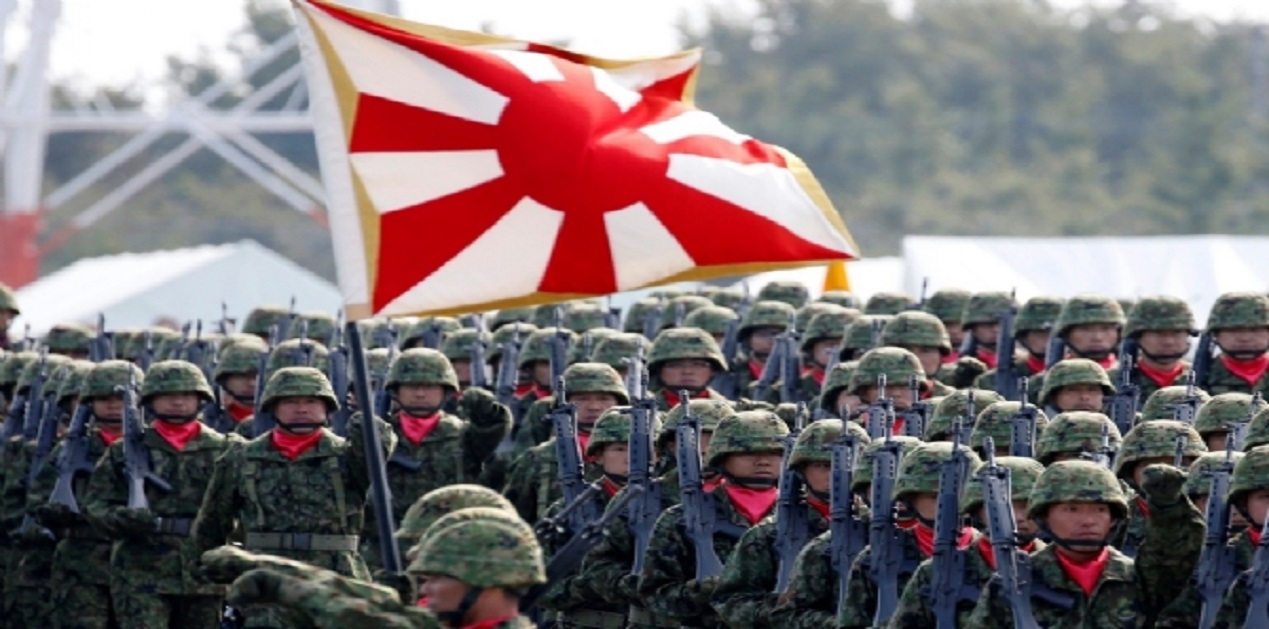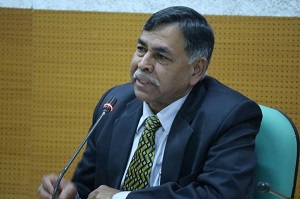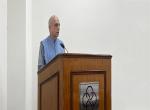Introduction
In a dramatic departure to Japan’s exclusively defensive posture embodied in the pacifist post-War Constitution of Japan, the Fumio Kishida administration effectively abandoned on 16 December 2022 when it passed ammendments to three key security documents after months of debate. In this major shift in the country’s defence policy, Japan signalled readiness to shed some of its post-War military constraints. This means that Japan shall now possess the capability of striking at enemy bases preparing to launch an attack on Japan. This decision means Japan shall have to enhance its defence spending. Finding funds for this requirement is another challenge that the Kishida administration shall be confronting now.
The revision issue of the peace clause enshrined in Article 9 of the Constitution is not recent. Opinions remained divided when the Supreme Commander of the Allied Powers Gen Douglas MacArthur drafted the Constitution and imposed on Japan. A defeated and demoralised Japan at that time had no voice to oppose it and had to accept it in its totality. Those who oppose such a view hold the opinion that some Japanese were co-opted with the drafting committee to finalise the document and therefore the argument that it was imposed is fallacious. That is a minority view however. Since under the cover of a peace Constitution Japan successfully concentrated on economic growth and remained protected under the US nuclear security umbrella, opposition to amend the peace clause remained muted.
Factors that precipitated move for boosting defence
The security environment surrounding Japan is already in the flux. After neighbouring China acquired robust military muscle, it has raked up the territorial issue over the control of the Senkaku island chains with Japan. China’s aggressive stances on the Taiwan Strait and South China Sea have already vitiated the security of the region. Japan also found compelling reason to bolster its military because of North Korea’s missile firings over its airspace and frequent threatening statements. Japan has also developed reservations on the US as its main security provider.
The US from its side has also encouraged Japan to increase defence spending in the light of China threats. The US is keen to assemble a coalition that could deter a military conflict with China in the larger interest of regional peace and stability across the region. The US is encouraging both its allies in Northeast Asia – Japan and South Korea – nearest to Taiwan, the island democracy off the coast of mainland China that has emerged as the fulcrum of the US competition with the communist regime to strengthen their military profiles.[1] For the US, Japan as a treaty ally plays an indispensable role in the maintenance, protection and defence of a free and open Indo-Pacific, besides upholding the values shared by the Quad members in pursuing many of the common interests — security interests, economic and political interests.
If one looks back to the background of Japan’s security policy, one aspect needs to be factored in that even during the 1950s; the Eisenhower administration of the US was worried about Japan’s neutralism. The powerful pacifist feeling after its defeat led Japan to keep its military budget low. Such a policy was allowed to continue because the US was powerful and it did not have to expect any military contribution from Japan. As a result, in 1978, Japan and the US crafted defence guidelines to defend Japanese territories but it was barely discussed about responsibility regarding neighbouring areas. Such times of contended acceptance of Japan’s passivity ended many decades ago. The US expects now Japan to share responsibilities, especially for regional security. The current debate of security burden-sharing stems from this narrative.
If Japan spends about $49 billion on national defence in fiscal 2022, it would bring the defence budget to about 2 per cent of the country’s GDP. If this is materialised, Japan would have abandoned its traditional 1 per cent cap and aligned in line with the targets that NATO member-states have adopted for trans-Atlantic security. Japan’s Defense Ministry admits that Japan is still at a low level compared with the GDP ratio of other major countries. Japan seems determined now to correct this. For now Japan maintains only modest military capabilities. This is now in the process of an overhaul, putting the world’s third largest economy in the process of emerging a military heavyweight in the region.
Japan’s move to acquire counter-strike capabilities as enunciated in its National Security Strategy (NSS) evoked sharp reaction from North Korea and China. North Korea lost no time in reacting that it will take ‘actual action’ against Tokyo’s new security strategy and rejected claims that it was for self-defense. North Korea’s foreign ministry issued a statement released through the official Korean Central News Agency said that “Japan’s adoption of a new security strategy that officially formalises possession of pre-emptive strike capabilities against other countries is creating a serious security crisis in the Korean Peninsula and East Asia”. It warned that it would respond appropriately to Japan’s “rearmament” decision[2] and slammed its military build-up as a flagrant violation of the UN Charter. This shows that the memories of Japan’s past military actions are not erased yet.
Interestingly, the first NSS released in 2013, nine years ago, had identified North Korea as the foremost security threat. This time, it was China, despite that North Korea launched dozens of missiles of various types, including one on a trajectory that overflew Japan. In fact the year 2022 was the busiest year of missiles testing ever. Though North Korea is mentioned as one of the main threats listed in the 2022 NDS document, China gets more attention as the first country cited as a security challenge in the Indo-Pacific region.[3]
The NSS clarifies that acquiring counter-strikes capabilities would not violate Japan’s pacifist post-war Constitution as these are not the same as pre-emptive strikes. The NSS explained that striking bases is permissible if it is deemed that there are no other means to defend against attack by guided missiles and others and thus such acts would be treated as “self-defence”. Counter-strike means hitting back at the opponent after they conduct the attack first, as opposed to pre-emptive strikes that are conducted when the enemy is about to strike. Therefore, the strategy is to deter North Korea from carrying out strikes against Japan by imposing costs and striking at North Korean missile-related sites if they take that action. The NSS does make it clear that any such measures that Japan may be forced to take would be in cooperation and consultation with the US and therefore the division of responsibilities with the US will remain unchanged. Despite the missile firing issue, the most vexed issue in Japan-North Korea relations is the abduction of Japanese nationals in the 1970s and 1980s, which remains one of Japan’s long-standing concerns. The truism is that Japan is compelled to hike defence budget to record high in order to have the capabilities to deter North Korea’s missile threats. The Kishida government has an enormous responsibility to explain its defence plans to gain the support of the public, lawmakers and bureaucrats.[4]
Opinions started building slowly if the peace clause should remain permanently when the world geopolitics has changed or Japan revisits its security posture. That has remained an arduous journey for successive governments to revisit and make efforts to adopt appropriate measures accordingly. The status quo ante remained until 1956 when the government announced that the Constitution did not specifically prohibit Japan from protecting itself in the prevailing manner. During the administration of Ichiro Hatoyama from 1954 to 1956, the Cabinet openly started articulating that possessing such capability was within the limits of self-defence.[5] Having chosen that position, the government had no courage to venture into a terrain that could have the unpredictable consequences, which it could not fathom. Such posturing led successive governments to delay and not take any concrete move to initiate the process of revision.
The possible considerations for the successive governments could have stemmed from two considerations: strong possible public disapproval and finding huge funding for the purpose. First, the public opinion is overwhelmingly against Japan returning to militaristic way of the past. Second, such a programme would entail huge outlays for defence equipment that successive government could have found prohibitive. Japan had also to factor into the possible reactions from neighbouring countries such as Koreas and China if Japan goes to strengthen its military as they are wary about Japan’s return to the militarist past. The Kishida government has now shed that inhibition.
This being said, the credit to initiate the process to make Japan a ‘normal’ state, however, must go to the slain Prime Minister Abe Shinzo, not Kishida. Given the tough political conditions, Abe was not able to execute his plan as he wanted. Kishida now wanted to complete Abe’s unfinished agenda. Days before Abe decided to step down in September 2020 on health grounds; he had initiated the process and left behind a document that summed up his thoughts on Japan’s defence, including concerns that ballistic missile defence systems alone would not be enough to protect the nation from potential enemy attack. Abe had also suggested that discussions on the issue of Japan possessing strike capability against enemy missile bases may continue after he demitted office. Therefore, when Kishida government approved the National Security Strategy on 16 December, it was in continuation on Abe’s policy.
As expected this fundamental shift in policy evoked sharp reaction from experts holding divergent views. While some felt possessing the new capability would serve as the core of the strategy to interfere with any Chinese move to change the international status quo through military force and possessing the strike capability would deter such moves by China, others felt that if Japan possesses such capability, it would make Japan dangerous in the eyes of its neighbours, rekindling past memories. Besides increasing instability, the move could trigger a new arms race in the region, adversely impacting the economies of the nations in the region, it was feared.
Key challenge is to find funds
The plan for increased defence spending totalling 43 trillion yen between fiscal 2023 and fiscal 2027 would still fall short by 1 trillion yen. As it transpires, the move may be laudable but finding necessary funds for this is not that easy. This needed tweaking annual tax reforms, including a general plan to raise taxes to fund increased defence spending, raising caps for a tax-free investment programme and a plan to impose higher taxes on the super wealthy. A expected, funding rise in defence spending created a political rift within the ruling Liberal Democratic Party (LDP).[6] The people will also not be ready to endorse such a policy as they will be unwilling to shoulder such tax burden. Some LDP members opposed tax hikes and preferred the use of government bonds.
After intense debate, the LDP finally agreed to a basic framework of tax hikes worth about 1 trillion yen, including a corporate tax surcharge of 4 to 4.5 per cent to secure about 700 billion yen, a 1 per cent surcharge on individuals’ income tax to raise about 200 billion yen, and an increase of the tobacco tax of 3 yen per cigarette for another 200 billion yen. Initially, Kishida wanted to appropriate about half of the special tax intended to help reconstruct areas affected by the March 2011 earthquake and tsunami. The reconstruction tax of 2.1 per cent on individual income tax generates about 400 billion yen in revenue for the government each year and was planned to run till 2037. Finally, another plan as a compromise was mooted and accepted, according to which the reconstruction tax was cut by 1 per cent and its duration was extended, thereby creating room for an addition of 1 per cent towards income tax surcharge. The implementation date was left open for further discussion.
It may be critical to secure financial resources for defense spending in case of national emergencies but the discussion on the sources to raise funds either from corporate tax or other taxes remains inconclusive. But the haste in which Kishida announced his plan to hike taxes for defence spending took many of LDP members off guard. In a sort of damage control move, Koichi Hagiuda, head of LDP’s Policy Research Council, said there is need for more discussion on finding funding sources other than raising taxes.
There was yet another reform plan geared towards raising money for defence spending. This relates to tax-free investing programmes that could facilitate investment among individuals. The aim is to boost asset-based income among the general public. To be called as Nippon Individual Savings Account (NISA), the plan is to make it permanent and to commence from 2024, with annual investment cap that could double to 2.4 million yen and the longer-term one to be tripled to 1.2 million. People shall have the option to invest up to 18 million yen during their lifetime. To make it attractive for the people to participate, investment and tax-exemption periods were to be made permanent. The objective of this proposal was to tap the huge financial assets held by Japanese households sitting in basic savings accounts or held by cash. By upgrading the NISA programme, the government hopes to double the amount of investment in NISA to 56 trillion in five years.
Other tax reform measures in the agenda contains higher tax burden on the super-rich. This, if adopted, could lead to heart burns in many. Other reform package includes tax-free incentive for investors for up to 2 billion yen if they reinvest their profit from selling stocks in start-ups.[7]
The public opinion is heavily against Kishida’s move and this would lead his political future to hang in balance. A day after the decision was announced; a Kyodo News poll found that 64.9 per cent of respondents disapproved the plan to raise taxes to finance a substantial increase in the nation’s defence spending.[8] The support rate for Kishida Cabinet remained at 33.1 %. The Asahi Shimbun survey showed that the approval rate plummeted to a record low of 31 % as a majority of voters opposed the government’s funding plans for increased defence spending.[9] These demonstrate that Kishida’s path is arduous and his political future hangs on a tight rope. It is a huge responsibility for Kishida to convince the people that the country’s security is vulnerable and needs to be appropriately prepared to defend from potential enemy attack. This is a real test of his leadership.
Endnotes :
[1]Joel Gehrke, “US encourages Japan to increase defense spending in light of China threat”, 19 December 2022, https://www.washingtonexaminer.com/policy/defense-national-security/us-encourages-japan-to-increase-defense-spending-in-light-of-china-threats
[2]Shreyas Reddy, “North Korea threatens Japan over its move to acquire counterstrike capabilities”, 20 December 2022, https://www.nknews.org/2022/12/north-korea-threatens-japan-over-its-move-to-acquire-counterstrike-capabilities/
[3]Shreyas Reddy, “Japan’s new security strategy backs counterstrikes against North Korea attacks”, 19 December 2022, https://www.nknews.org/2022/12/japans-new-security-strategy-backs-counterstrikes-against-north-korean-attacks/
[4]Ryo Hinata-Yamaguchi, “North Korean missile threats drive Japan’s defense budget to record high”, 14 September 2022, https://www.nknews.org/pro/north-korean-missile-threats-drive-japans-defense-budget-to-record-high/
[5] “Exclusive defense posture in name only with new strike capability”, Asahi Shimbun, 17 December 2022, https://www.asahi.com/ajw/articles/14795206
[6]Kazuaki Nagata, “Tax Reform package takes on defense spending and individual investors”, The Japan Times, 16 December 2022, https://www.japantimes.co.jp/news/2022/12/16/business/economy-business/tax-reform-package-proposal/?utm_source=pianoDNU&utm_medium=email&utm_campaign=72&pnespid=8P
[7]Ibid.
[8] “Poll shows nearly 65 % disapprove of tax hikes to cover Japan’s increased defense budget”, Japan Times, 19 December 2022, https://www.japantimes.co.jp/news/2022/12/19/national/politics-diplomacy/kishida-japan-defense-budget-tax-poll/
[9] “Survey: Kishida Cabinet approval rate slides to record low 31%”, The Asahi Shimbun, 19 December 2022,
https://www.asahi.com/ajw/articles/14796337
(The paper is the author’s individual scholastic articulation. The author certifies that the article/paper is original in content, unpublished and it has not been submitted for publication/web upload elsewhere, and that the facts and figures quoted are duly referenced, as needed, and are believed to be correct). (The paper does not necessarily represent the organisational stance... More >>
Image Source: https://www.newsbharati.com/Encyc/2022/12/28/Japan_202212281257582594_H@@IGHT_0_W@@IDTH_600.jpg











Post new comment